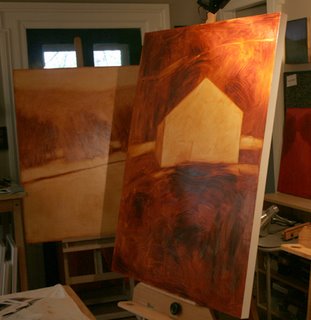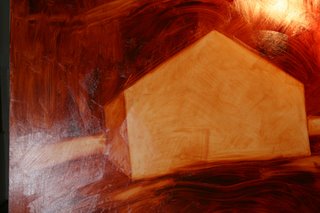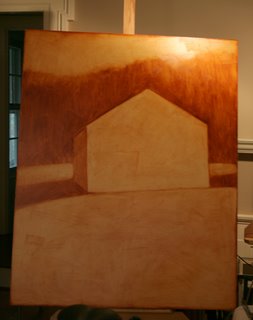
I tried to post on Tuesday but our satellite was down for most of the day because of weather, rain, not snow yet, thankfully. So I spent the day working on the underpaintings on the big panels. I had gessoed the panels on Monday, sanded them and so they were all ready to go.
I thought I'd describe how I do the underpaintings in a bit more detail. The first thing I do is to rub paint all over the panel. I used a whole tube of paint on each of these panels! Too bad most of it gets rubbed off. Cotton cloths work well here, no paint brushes for me at this stage, I could if I wanted to but I prefer the effect I get from using a cloth.
Then I start to form the image by pulling out the light areas and leaving the darks. My focus here is to get the drawing right, the forms and the lights and darks established. I also try not to think and plan too much as I tend to overwork if I do that. This is where listening to music or talk radio comes in really handy. However, I do have to think a bit about whether I will use a light or a dark color in a specific area. If I leave an area dark in the underpainting, then I am limited as to which colors I can use in order to keep the washy, layered look that I prefer later on. But that is about the most thought I put into the painting at this point. The rest is mostly instinctive-and pretty much the only question I ask myself is whether or not it "looks right".
There is another aspect that I have to balance here though. I would prefer to leave the underpaintings very dark and moody and expressive, but if I do that it is technically really difficult to layer the colors over it later. It becomes too dark or has a "pastey" look to it that I don't like. So I have learned to keep the underpaintings lighter and simpler. I can always add things in later (often I leave windows or doors out in the underpainting) if I want, though I don't do that too often. And if I am not sure about the colors that I will use (normally I have no idea what colors I will use at this point, I decide that later, uh, pretty much at the very moment that I begin to paint) I will make the area really light so I will have more flexibility later on when I choose colors.
This is the large panel about halfway finished. You can see the other large panel on the left:

And a closeup (sorry about the glare on these) :

I am not sure what color the foreground will be so I decide to pull all of the paint off in case I decide that it must be yellow. I also make some adjustments to the barn and shadows. At first the barn was short and squat, which I liked but I didn't really like how it worked with the rest of the composition, so I changed it to a more traditional proportion. Sometimes giving up a part, no matter how much you like it, helps the whole. Remembering that has helped me out of quite a few jams.
And here it is finished.

I consider the underpaintings to be sketches, but really they are an integral part of what you see in the painting. They do much of the work of the image, they are the bones. And I love doing the underpaintings. I love to get my hands in the paint, though now I use gloves instead of bare hands, and I love to create the volume and mood. At first I just wanted to make these, and while they seemed finished to me no one else thought they were, and I began to use color. And then they really started to sing. But while I love the color too, the process of making the underpainting is what really gets me. Often, as I discussed here, I use a different color and leave them as is.
So go ahead and try working like this sometime. It's a good change of pace and can give you a new way to look at things. I prefer the earthier colors now, but I have used many other colors in the past. Blues and greens are effective if you are painting the figure, the flesh colors look amazing over blue, and for a few years after college I did a number of paintings in black, using turpentine to really get the light areas. I have worked with and without brushes and with and without turpentine. It takes some experimenting to get comfortable as it is quite different than working all prima. I have been working with the underpaintings and glazes so long now I am a bit flummoxed when it comes to alla prima anymore!
And this is going to sound really corny, but this whole process really fulfills the various needs that I have as a painter. I get to be really spontaneous, but then I have to show some restraint and patience by working just a little bit each day in order to complete the piece. There is a constant push and pull between those two elements, hurry up and wait. I really dig that. Or that digs me. Either way.

12 comments:
I am always intrigued by your underpaintings. Like you, I think that the do have a finished feel to them. As for myself my underpaintings are tonal but I use color from the get-go the difference being that I try to do it with complementary or discord colors. I find that it works best for me but I still love seeing others use a grisalle approach. Glad to see that you jumped in with those large panels.
Thanks Ed, we do all work a bit differently and with what works best for us. I learned several different underpainting methods in college and while I was intrigued, I went on to develop my own manner of doing them. I hope to keep experimenting too, and it would interesting to do more tonal underpaintings someday. Another thing to put on my list!
It was great to do those large panels and I'll probably talk a bit more about it tomorrow.
Great demo. Do you teach?
Bob
That is so cool.
Bob, thanks. I don't teach. I have been asked to do workshops but I am extremely uncomfortable in front of groups, I would never be able to do a live painting demonstration and, I don't know, I am just not interested in teaching. It would seem a bit surreal also, because I still feel like I am the one who still needs to take classes. I am glad though that my online demo is ok.
Thanks Meno.
Wow - wonderful look into your process! Thanks for sharing. Interesting approach to be taking away instead of adding on to create the original composition.
And it looks great - you seem to be handling the size quite well.
Thx for sharing the process, Tracy.
The final result is very beautiful.
Really cool process! Makes me want to get back to oils! Anyone ever heard of laying down the complementary colors in the underpainting and then using the correct colors for the layers. Like: paint red trees in the under painting and then green on top?
You've jumped into the large size really successfully. It's fascinating reading about and seeing your process. I always think that potential buyers would appreciate work more if they knew all this. I wonder if galleries could use an edited copy of some blogs to educate themselves -?
Anyway, I am enjoying it. It is also a delight to watch someone creating with joy.
Lisa, Reductive drawing-I have always tended to work that way, even with pencil or charcoal I like to put down lines and then remove them with an eraser to create forms.
Thanks Daniela. I have been sighing in relief for a few days that they are looking good so far!
Terri, I don't work in that manner but it sounds like Ed does, he works a lot with complementary colors. Sound like an interesting thing to try some time though!
Hi Omega, Editing would be important! I am sure clients wouldn't be too interested in hearing about my chickens or my opinions about Rockstar/Supernova. Glad you are enjoying this.
I want to write my comment before I read the others. I see Ed might be saying something similar, but I will write first.
This is the first under-painting of yours I have seen. I like it. There is strength and solidity. I think combined with the large panel size, this will be powerful in life especially.
The colors are less "pretty" than some of those in your finished pictures. I never thought of this word "pretty" in looking at your work before, but seeing the underpainting brings it to mind. The underpainting has a more sombre quality which does something for me. I think that in this picture the strong shadow fits with this mood.
There is an effect of lighting which I think is accidental glare, in the upper right corner of the photo of the finished underpainting. Whatever it is, it looks good.
I sometimes leave paintings at the underpainting stage because I like the colors. I often think about how to maintain that underpainting magic quality while also making the complete statement of the finished painting, but I have not quite worked it out yet. It has to do with overpainting not too much, not too covering everywhere, not too thick everywhere. But that is obvious, and still I don't feel satisfied. There must be a concept that I am missing.
Hi Karl, You are right, the underpaintings are not "pretty", which is why I like them too and am always tempted to leave them. But I do like "pretty" too so it turns out that my painting encompasses both (they are less pretty in real life-the moodiness of the underpainting is visible) which is what I have always tried to manage.
I don't know if there is a concept that you are missing if you are having difficulty getting the balance that you want. I think it's more a matter of skill and instinct together, which takes time to develop. As well as dumb luck and maybe some input from others. Often my husband will really insist that I stop working on a painting before I overwork, which is something I tend to do.
Post a Comment